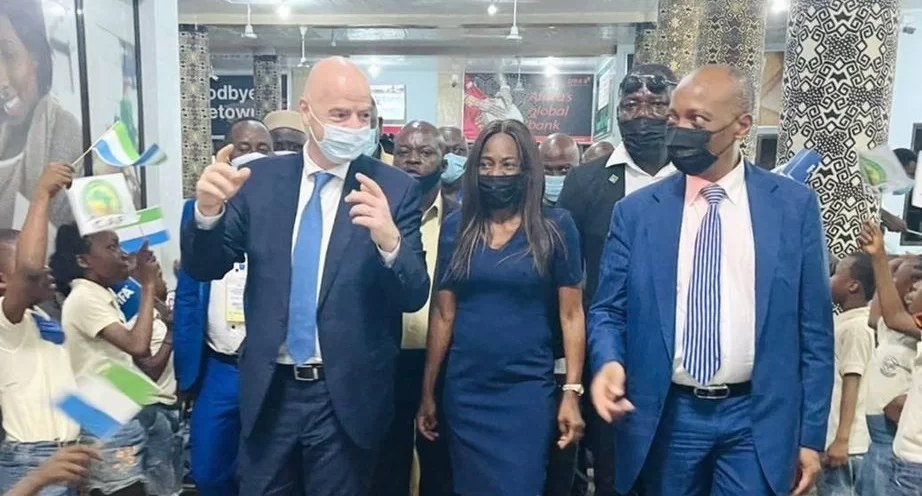By Alusine Fullah
Depending where you find yourself, corruption in sports has been topical may be since the days of Adams. As sport activities have evolved in recent decades, in terms of professionalism, globalization and accessibility, so the type of corruption that affects it and its scale has grown. As a result, comprehensive legislative and regulatory frameworks and related tools are required to effectively combat corruption in all its forms.
The evolution of sport, especially in its globalized nature, has exposed it to new and sophisticated forms of corruption that often involve transnational organized criminal groups. The influence and threat posed by criminal organizations to sport is an issue of increasing concern to Governments, sport organizations and the private sector alike.

The seriousness of this threat has been amplified by the drastic impact of the COVID-19 pandemic, Ukraine war and now Gaza war which have made sport more vulnerable to corruption and organized crime.
The involvement of organized crime in sport is a serious threat to the social role of sport and to the ethos and values that underpin it. Organized crime groups use corruption to facilitate their infiltration of sport and make it possible to exploit it in both its amateur and professional forms at local, national, regional and global levels. They exploit sport through illegal betting, competition manipulation and human trafficking to generate illicit profit. However, they also use sport as a vehicle to project power and influence in local communities, often with devastating consequences, particularly when their activities have an impact on children, young athletes and vulnerable groups.
Ensuring that sport is a safe space for children and young athletes by tackling the corruption that puts them at risk and prevents them from realizing their potential are areas of increasing focus and interest, including for States and sports organizations. It is important to acknowledge that corruption impacts all levels, including the amateur, youth and grassroots levels. This corruption can include the embezzlement of funds and the use of bribes to get enrolled into a sports academy, to secure a place on a team or to make undue payments to amateur players. Equally important to acknowledge is how corruption can facilitate abuse in sport. This topic is addressed in detail in the section on corruption and abuse in sport. Abuse in sport can lead to insurmountable psychological trauma, unjustly deprive talented young athletes of a chance to compete and hinder the development of national sport.
Match-fixing is therefore a major threat to sport. In Africa, Sierra Leone to be specific, citizens have complained about match-fixing. There are two different motives for match-fixing, both with ancient origins. Firstly, sport may be fixed for sporting reasons: bribes may be paid or other inducements offered to encourage one individual or team to lose a particular contest. Secondly, people may try to make money through gambling on a contest in which they know the outcome before it takes place because they have fixed the result.
Many people believe that the advent of online gambling has increased the risk of match-fixing for financial gain. It is possible to bet from one country on a minor league in a far-off land. The huge scale of the global gambling industry (legal and illegal) is attractive to organize crime and the range of the types of bets available potentially increases the value of inside information. Globalization also plays a role – criminals seeking to fix matches can connect and meet with athletes, coaches and officials from all over the world.
It has led to confusion about the precise nature of match-fixing in cricket with many erroneously believing bets can be placed on obscure events occurring. In fact those pre-arranged events (or inside information) can be used to profit on the outcome of the match, or match odds, over a short period of time.
In organized sports, match fixing (also known as game fixing, race fixing, or more generally sports fixing) is the act of playing or officiating a contest with the intention of achieving a pre-determined result, violating the rules of the game and often the law. There are many reasons why match fixing might take place, including receiving bribes from bookmakers or sports bettors, and blackmail. Competitors may also intentionally perform poorly to gain a future advantage, such as a better draft pick or to face an easier opponent in a later round of competition. A player might also play poorly to rig a handicap system.
Match fixing, when motivated by gambling, requires contacts (and normally money transfers) between gamblers, players, team officials, and/or referees. These contacts and transfers can sometimes be discovered, and lead to prosecution by the law or the sports league(s). In contrast, losing for future advantage is internal to the team and very difficult to prove. Often, substitutions are made by a coach, designed to deliberately increase the team’s chances of losing (such as having key players sit out, often using minimal or phantom injuries as an excuse), rather than ordering the players who are actually on the field to intentionally underperform, are cited as the main factor in cases where this has been alleged.
Sport is integral to the achievement of the Sustainable Development Goals. Significant efforts have been made to develop policies and initiatives at all levels to make sport an accelerator of peace and sustainable development for all, including those aimed at strengthening the integrity of sport. However, there is a growing understanding that illicit activities, often involving an international dimension, pose a significant threat to sport’s role in the achievement of the Sustainable Development Goals. The last decade has seen a notable increase in the number of initiatives at the national and international levels to tackle corruption in sport and strengthen the integrity of sport. Their range and diversity reflect the complexity of the challenge and the fact that there is no “one size-fits-all” approach.
Effective detection and reporting mechanisms can help to develop a better understanding of the nature and scale of corruption in sports. Equally, such mechanisms can strengthen intelligence-led investigation processes and increase the likelihood of securing successful criminal prosecutions or sport-led disciplinary sanctions, thus allowing stakeholders to better safeguard the integrity of their sports. These mechanisms are also vital in helping to address and mitigate the impact of abuse on children and young athletes in sport, and on adult athletes, officials, fans and other relevant participants. Tackling the various forms of corruption in sport requires a strong criminal, administrative and civil response. It is also vitally important that sports organizations apply their capabilities to addressing wrongdoing in an effective, transparent and accountable manner. However, in many countries, criminal-justice and sports-organization responses are significantly hampered by a critical lack of human and technological resources and specialist skills.
Violence and abuse are pervasive global issues that affect women, men, boys and girls in all sectors of society and that cut across boundaries of age, race, religion, ethnicity, disability, culture and wealth. Women and children (both boys and girls) are most affected. Violence and abuse are often perpetrated by people victims know and abuse tends to flourish when there are power imbalances and a lack of accountability for perpetrators. Sport as a microcosm of society has not been spared from this violence and abuse.
The risk factors that are discussed in this section include unequal power relations between athletes and individuals in positions of authority, training environments that provide opportunities for abuse, institutional culture5 and the tolerance of violence in sport. A multidisciplinary approach to tackling these issues, which incorporates all perspectives, is needed for effective safeguarding. Recognizing the importance of coordination and collaboration between the various stakeholders that use different international legal and policy frameworks to address abuse in sport efficiently, this section highlights how the United Nations Convention against Corruption can be used to tackle abuse in sport. Corruption in sport, particularly in the form of the abuse of authority, facilitates violence, abuse and harassment.
The International Olympic Committee (IOC) recognizes this link in its consensus statement on sexual harassment and abuse in sport, in which it states that “sexual harassment and abuse in sport stem from power relations and abuses of power facilitated by an organizational culture that ignores, denies, fails to prevent or even tacitly accepts such problems.” An important point to note at the outset is that not all forms of abuse are forms of corruption.













